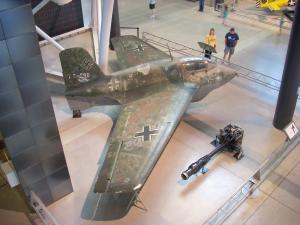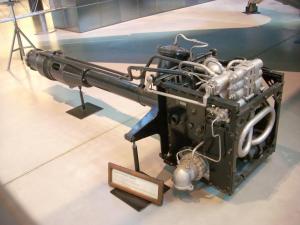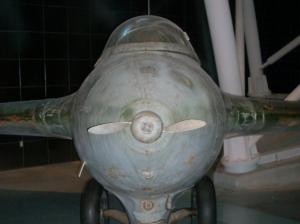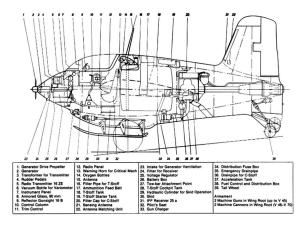
Photo 1. Me-163B-1a, Werk Nummer 191301 with Walter rocket engine at the Stephen F. Udvar-Hazy Center of the Smithsonian National Air and Space Museum, Chantilly, Virginia. 2016 (T. Fey)
The Seppeler Propeller on the Messerschmitt Me-163
by Tom Fey
Published 13 Apr 2018
The Me-163B powerplant was the Walter HWK-109-509 A1/A2 rocket motor, which used two-part hypergolic fuels (C-Stoff, T-Stoff) to produce 3,700 pounds of static thrust. The 336 gallons of fuel provided five to eight minutes of powered flight, and total flight times were well under 15 minutes.
The Me 163 rocket engine used a fuel-and-catalyst steam generator to feed a turbine which in turn drove the dual fuel pumps via worm drives. Combined fuel flow was 1,100 pounds per minute at maximum power. There were no pads on the engine to drive accessories such as a generator or vacuum pump; however the Me-163 required electrical power to energize the engine starter, artificial horizon, pitot tube heater, radio, identification transmitter, cannon firing solenoids, and instrument panel gauges. The production of this electrical power finally gets us to the topic of this article.
On the nose of the Me-163 is a small “Seppeler” propeller of 15.7" (40 cm) in diameter with a spinner approximately 3.9" (10 cm) in diameter, driven by the airstream in flight. The propeller spins clockwise when viewed from in front of the aircraft. Contrary to a typical aircraft tractor propeller, the upstream (impinging) face of the propeller blade is quite flat while the opposite side is cambered. This propeller directly drives a 2,000 watt, 24 volt, direct current generator to charge the 20 amp-hour storage battery secured in the nose of the aircraft. The Me-163 could attain speeds in excess of 590 mph, so one could ask what kept this wind milling propeller from over-revving both itself and the generator.
 |
 |
 |
 |
| Photo 2. Walter HWK 109-509 A-1 rocket engine on display at the Stephen F. Udvar-Hazy Center of the Smithsonian National Air and Space Museum, Chantilly, VA. 2016. The black cylinder at the top of the engine is the steam generator for the turbine. The large 90 degree silver elbow towards the bottom of the engine is the steam turbine exhaust. (T. Fey) | Photo 3. Seppeler generator propeller on the nose of the Me-163B shown at left. Note the intake for the generator cooling air on the midline below the propeller. Round receptacle below the cooling intake is a receiver for a tow bar. (T.Fey) | Photo 4. Seppeler generator propeller on the nose of the Me-163B, Werk Nummer 191660, at the Flying Heritage and Combat Armor Museum (FHCAM), Paine Field, Everett, WA, 2011 (T. Fey) | Photo 5. Me-163B diagram showing the location of the Seppeler propeller (1), generator (2), generator cooling trunk (23), and battery (26). From Air Force Museum, Gatow, Germany Me-163B Page |
Recently a gentleman named Friedrich Günther posted photographs of his Me-163 propeller on an Internet site and has kindly allowed me to share his photographs.
The first thing you notice is that the blades are attached to fittings alongside the central shaft, thus the blade axes are not in line with each other. (Photo 6) The second thing of note is that the blades are captured in the hub in a manner that allows them to pivot on their own axis and thus change pitch. There appears to be a counterweight at the root end of each blade and a central spring mechanism. Although I have not been able to locate an exploded diagram or obtain additional photographs, I believe the central spring is a pre-loaded circular torsion spring acting on a central drum. Wrapped around this drum are two braided steel cables. (Photo 7) One cable exits to the right at say the 12 o’clock position to engage a fitting on the shaft of one blade while the other cable exits the drum to the left at the six o’clock position to engage a fitting on the shaft of the other propeller blade. (Photo 8). There are pins in the assembly acting as pitch stops, and it appears the blades are up against the flat pitch stop in the accompanying photograph 7. I have been unable to determine the pitch range of the blades, or their static resistance to pitch change, without the risk of being forcibly escorted out of a museum.
I believe that at low airspeeds the blades are held against the low pitch stop by the central torsion spring mechanism, thereby providing sufficient blade area to the wind to drive the generator. But as flight speed increases, the airstream would otherwise drive the generator to increasing rpms, generating excessive electrical output and risking thrown armature windings, deformed then departing propeller blades, and increasing drag on the airframe. This is when centrifugal force on the counterweights and the geometry of the propeller assembly combine to override the force of the torsion spring, increase the pitch of the propeller blades, and thereby govern the rpm to an acceptable range at higher airspeeds. The spring resistance and counterweights were carefully designed to provide sufficient power via blade pitch to drive the generator without over-revving the system. A simple spring-loaded feathering system would not do the job. While likely not a true constant speed propeller, the Seppeler propeller is certainly self-regulating and of ingenious design.
I have been unable to locate additional details on the generator itself, but at 2,000 watts, it is absorbing at least 2.7 horsepower (one horsepower = 746 watts) from the propeller as well as a thrust load down the shaft not usually experienced by standard generators. I estimate the generator shaft to be 0.39 inches (10 mm) in diameter, but don’t know exactly how the propeller was affixed to the shaft. (Photo 9). Looking at the photographs of the nose of the Me-163, a small port can be seen on the centerline below the propeller. This is an intake for an angled trunk that guides cooling air to the generator. (Photo 10)
The term “Seppeler propeller” was fortuitously used in the Wolfgang Späte book listed in the references. An Internet search revealed a U.S. Patent 1,851,874 for a “Propeller for Flying Machines”, granted on March 29, 1932, to Eduard Seppeler of Berlin-Neukolln, Germany. This patent describes the use of a torsion spring assembly, low friction helical ball bearings in the blade roots, pilot-adjustable pitch range stops, and the use of centrifugal force to regulate propeller pitch. The patent does not specifically describe the propeller system found on the Me-163, however all the basic design elements found in the Me-163 propeller are described in the Seppeler patent.
References
Späte, Wolfgang. Top Secret Bird. Missoula, Montana: Pictorial Histories Publishing Company, 1989.
Zeigler, Mano. Rocket Fighter. New York, New York: Bantam Books, 1984.
Green, William. Warplanes of the Third Reich. Garden City, New York: Doubleday and Company, Inc., 1970.
Maloney, Edward T. and Ewe Feist. Messerschmitt 163, Aero Series Vol. 17. Fallbrook, Calif: , Aero Publishers, Inc., 1968.
Seppeler Propeller Patent: https://patents.google.com/patent/US1851874
Me-163B Page at the Air Force Museum, Gatow, Germany http://www.bredow-web.de/Luftwaffenmuseum/Historisch/Me_163B_Komet/me_163b_komet.html